Marketing data visualization is the process of using visual representations to communicate marketing data and insights. It can be used to identify trends, patterns, and relationships in your data, as well as to tell stories and make your data more engaging and accessible.
As a digital marketing agency, we’ve seen firsthand how effective marketing data visualization can be and often spend as much time organizing and displaying data visualizations as we do preparing data When used correctly, data visualizations can help you to:
- Make better marketing decisions
- Communicate your marketing results more effectively
- Engage and persuade your audience
In this blog post, we’ll share some of our best practices for marketing data visualization.
Know Your Audience
The first step to creating effective marketing data visualizations is to understand your audience. Who are you trying to reach with your data? What do they need to know? Once you understand your audience, you can tailor your visualizations to their needs and interests.
Choose the Right Visualization Type
There are many different types of data visualizations, each with its own strengths and weaknesses. The best way to choose a visualization type is to consider the purpose of your visualization and the type of data you’re trying to communicate.
For example, if you’re trying to show a trend over time, a line chart or bar chart would be a good choice. If you’re trying to show the relationship between two variables, a scatter plot or correlation matrix would be a good choice.
Keep it Simple
One of the most important principles of data visualization is simplicity. Avoid using too many colors, fonts, or chart types in a single visualization. This can make your visualization cluttered and difficult to understand.
Instead, focus on using a simple and consistent design that allows your audience to focus on the data.
Use Clear and Concise Labels
All of your data visualizations should be clearly and concisely labeled. This includes labeling the axes, data points, and any other relevant elements of your visualization.
Clear labeling helps your audience to understand what your visualization is showing and how to interpret it.
Tell a Story
The best data visualizations tell a story. They use data to communicate a specific insight or finding. When creating your data visualizations, think about the story you want to tell and how you can use data to support that story.
You can use text, titles, and subtitles to help tell your story. You can also use visual elements such as color, size, and placement to emphasize the key points of your story.
Our Expertise
Being able to measure the success of our client’s initiatives and marketing campaigns is of critical importance to our team. We strive to provide transparent metrics at relevant intervals, like:
- Weekly updates on KPIs, including recommended optimizations and budget racing.
- Monthly campaign and channel performance review, including test results, and recommended enhancements.
- Quarterly brand reviews that give a high-level overview of channel and business health, plus plenty of ideas and strategy updates and any audience adjustments.
Wish you could get a better handle on your marketing data and view it in an easy-to-digest format? We can help you wrangle your marketing and customer data and turn it into actionable insights.


